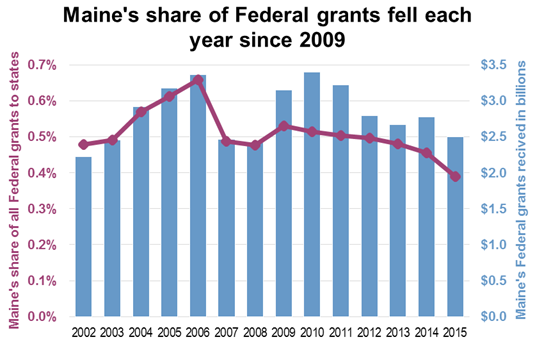“Our primary reason for supporting this bill is the need for more transparency from the executive branch and the department. We believe Maine needs to do better. Mainers have a right to know how their money is being spent – or why it is being turned away. Jobs and economic development are at stake. And more importantly, so is the health of our friends and neighbors.”
Good morning, Senator Brakey, Representative Hymanson, and members of the committee on Health and Human Services. My name is James Myall, and I am a policy analyst at the Maine Center for Economic Policy and I’m here to testify in support of LD 567. MECEP is very concerned about how the Department of Health and Human Services is managing federal funds and grants. Tomorrow we will be releasing a report on our research into the topic, which finds troubling instances where the department has either failed to apply for or turned back grants or left money unspent.. We support LD 567 as an effort to increase transparency at the department, and we urge the committee to hold the department accountable for its use of federal monies.
Federal funding is an essential component of Maine’s overall budget and of our economy. Federal funds account for approximately one third of the overall state budget,[1] and overall, federal spending in Maine comprises almost 40% of the state’s GDP.[2] Maine is a net beneficiary of federal funding, meaning that Maine taxpayers receive more support from the federal government than we contribute in taxes. This is part of the fundamental compact between the federal and state governments. Every American contributes to the federal pool, which is redistributed to the states according to their needs. Rejecting federal funding for projects is not “good fiscal management” – it is selling short the taxpayers of Maine by sending their money elsewhere.
You will hear from others today about the effects of declined federal funding on specific projects – from cancer screenings to well-water testing and mental health services. So I will focus on the bigger picture. In 2010, Maine received 0.5% of all federal funding to the states; by 2015, that had fallen to just 0.39%.[3] That’s less money for hungry and sick Mainers, and less stimulus for our state economy. Over that same period, the balance in the state’s federal funds account has grown year after year, to an unspent balance of $29 million.[4] Excluding 2009, when the state received a significant amount of Recovery Act money, that’s the largest balance in the fund since at least 2002.[5] That unspent money represents declining(?) public health, jobs and economic development.

Sources: Maine State Auditor, Single Audit Reports , 2002-2015, US Office of Management and Budget, Budget of the United States Government, FY15, Table 12.1, “Summary Comparison of Total Outlays for Grants to State and Local Governments: 1940-2017.”
Federal programs have real impact on Mainers, and this decline in federal grants to the state has coincided with a decline in Mainers’ health. In 2008, America’s Health Rankings found Maine to be the 8th healthiest state in the Union. By 2016, our relative position had fallen to 22nd. That’s our worst position in the 26 years the measure has been compiled.[6] As a committee, I’m sure you’re all aware of the number of pressing public health issues facing the state – tobacco use, a climbing infant mortality rate, the opioid epidemic. This is not a time to be turning away help.
Our primary reason for supporting this bill is the need for more transparency from the executive branch and the department. We believe Maine needs to do better. Mainers have a right to know how their money is being spent – or why it is being turned away. Jobs and economic development are at stake. And more importantly, so is the health of our friends and neighbors.
Thank you. I’m happy to take any questions.
[1] Maine Office of Fiscal and Program Review, http://legislature.maine.gov/legis/ofpr/total_state_budget/index.htm
[2] Pew Charitable Trusts, “Federal Spending in the States, 2005-14,” http://www.pewtrusts.org/en/research-and-analysis/issue-briefs/2016/03/federal-spending-in-the-states-2005-to-2014
[3] US Office of Management and Budget, Budget of the United States Government, FY15, Table 12.1, “Summary Comparison of Total Outlays for Grants to State and Local Governments: 1940-2017”
[4] It appears that this number is exclusive of the $151 million in unspent TANF monies.
[5] Maine State Auditor, Annual Single Audits, 2002-15.
[6] America’s Health Rankings, Maine: Annual Report 2016, http://www.americashealthrankings.org/explore/2016-annual-report/state/ME
[pdf-embedder url=”https://www.mecep.org/wp-content/uploads/2017/03/Testimony-in-Support-of-LD567.pdf” title=”click here”]


